The 10 Best Ornamental Trees to Grow in Connecticut
A garden is a reflection of its gardener, and no two gardens are alike. Yet one type of plant can be found in almost every garden: the ornamental plant. Ornamental plants are prized for their beauty, and they come in an endless variety of shapes, sizes, and colors. They can add interest to an otherwise plain garden or create a stunning visual display. In addition to their aesthetic value, ornamental plants also serve an important function in the ecosystem. Many of them are pollinators, and they provide food and shelter for wildlife. While selecting these plants, it is important to ensure they can thrive in your area. Here are Ornamental plants that you can grow in Connecticut.
1. Sweetbay Magnolia (Magnolia virginiana)
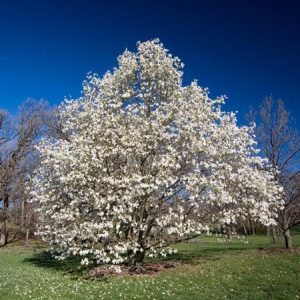
Sweetbay Magnolia (Magnolia virginiana) is an ornamental plant native to the southeastern United States. A small tree typically grows 20-30 feet tall and 15-20 feet wide. The leaves are evergreen, dark green in color, and 6-8 inches long. The flowers are white and fragrant and bloom in late spring or early summer. The fruit is a red, fleshy drupe that matures in late summer or early fall. Sweetbay Magnolia is tolerant of various soil types and prefers full sun to partial shade. It is also relatively drought-tolerant once established. Sweetbay Magnolia makes an excellent addition to any landscape due to its showy flowers, handsome foliage, and attractive fruit. It is relatively low maintenance and can tolerate both sun and shade. Additionally, it is resistant to most pests and diseases.
2. Prairiefire Crabapple (Malus x Prairiefire)

The Prairiefire Crabapple is a deciduous tree that grows to be about 15-25 feet tall. It has a spreading habit and a rounded crown. The leaves are 2-4 inches long and have a deep purple color. The flowers are pink or white and about 1 inch across. The fruit is about ½ inch in diameter and ripens to a red or purple color.
This tree thrives in full sun and prefers moist, well-drained soil. It is tolerant of heat, humidity, and drought. It is also resistant to disease and pests. Prairiefire Crabapples can be planted in spring or fall. They should be spaced about 15-20 feet apart.
Prairiefire Crabapples are generally low-maintenance trees, but they will benefit from regular watering and occasional fertilization. They are also susceptible to pests and diseases, so check your tree regularly for signs of problems.
3. Thundercloud Plum (Prunus cerasifera ‘Thundercloud)
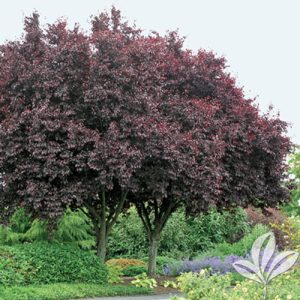
The Thundercloud Plum (Prunus cerasifera) is a small deciduous tree native to Europe and Asia. Its attractive flowers and foliage are commonly grown as ornamental plants. The Thundercloud Plum typically grows to a height of 10-15 feet, with a spreading canopy of branches. The leaves are ovate and have a glossy green surface. In the springtime, the Thundercloud Plum produces clusters of white or pinkish-white flowers. These flowers are followed by small, red fruits that ripen in the summer. The tree can be successfully cultivated in USDA hardiness zones 4-8. Thundercloud Plum trees are often used as ornamental plants due to their attractive flowers and foliage. They are also popular because they are relatively easy to care for and disease-resistant. Additionally, Thundercloud Plums are tolerant of various soil types and can even tolerate drought conditions. Overall, the Thundercloud Plum is an ideal ornamental tree for those looking for a low-maintenance plant that will add beauty to their landscape.
4. Pink Dogwood (Cornus florida var. Rubra)
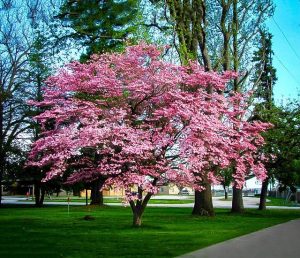
The Pink Dogwood (Cornus florida var. Rubra) is a beautiful ornamental plant native to the eastern United States. The tree gets its name from its stunning pink flowers, which bloom in the spring and summer. Pink Dogwood grows to a height of 30 feet and has a spread of 20 feet. The leaves are Alternate, simple, elliptical to ovate, 6-8 inches long, and 2-3 inches wide. They are dark green above and lighter green below with a smooth margin. The flowers are white, borne in large clusters (cymes) at the ends of the branches. The fruit is a bright red drupe, 1/4 inch in diameter, which ripens in September and is attractive to birds. Pink Dogwood is tolerant of a wide range of soils and growing conditions but prefers moist, well-drained soil in partial shade. It is also tolerant of urban conditions and will thrive in full sun and shade. Pink Dogwood is an excellent choice for use as an ornamental tree in yards, gardens, parks, and other landscape settings.
5. Eastern Redbud (Cercis canadensis)
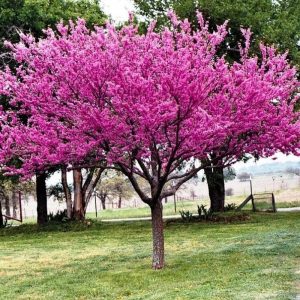
The Eastern Redbud (Cercis canadensis) is a beautiful, deciduous tree native to eastern North America. It typically grows to 20-30 feet and has a spreading crown. The leaves are heart-shaped, and the flowers are pink or white, growing in clusters along the branches. The flowers are pollinated by bees and other insects, which then eat the fruits that develop from the flowers. The fruits are eaten by birds and small mammals, which help to disperse the seeds. The Eastern redbud is also resistant to most diseases and pests, making it a low-maintenance plant. It is adaptable to most soil types and can tolerate both full sun and partial shade. The Eastern Redbud is relatively easy to grow and can do well even in cold areas. It prefers moist, well-drained soil and should be watered regularly during the growing season. For best results, plant Eastern Redbuds in early spring or fall. Gardeners in colder climates may want to protect young trees with a burlap wrap during winter.
6. Lilac Tree (Syringa reticulata)
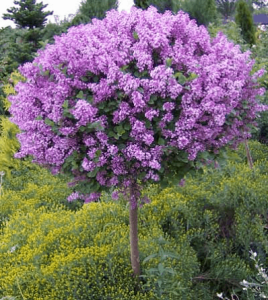
The lilac tree, botanical name Syringa reticulata, is a medium to a large deciduous shrub that is native to parts of China and Japan. It grows to a height of 15-20 feet and has a spread of 10-15 feet. The trunk is typically around 2-3 inches in diameter, and the branches are covered in smooth, gray bark. The leaves are ovate-shaped and measure 4-8 inches long and 2-4 inches wide. They are arranged alternately on the branches and are dark green. The lilac tree blooms in early spring, with the flowers appearing before the leaves. The flowers are purple or white and have a sweet fragrance. They grow in clusters of 6-12 and measure 1-2 inches across. After blooming, the flowers are followed by small, spherical fruits that turn black when ripe.
The lilac tree prefers full sun and well-drained soil. It is tolerant of a wide range of soil types but prefers loamy or sandy soils. It is also tolerant of drought but will flower best if given regular watering during dry periods. This tree is relatively low maintenance but requires pruning when it is being grown for ornamental purposes. It is also generally resistant to pests and diseases.
To grow a lilac tree from seed, plant the seeds in moist, well-drained soil in spring or autumn. Seeds can also be started indoors 4-6 weeks before the last frost date. Keep the soil moist but not wet, and place the pots in a sunny location. Once seedlings emerge, thin them out so that they are spaced 3-4 feet apart. Transplant seedlings into the garden after all danger of frost has passed. Water regularly during dry periods for best results.
7. Black Locust (Robinia pseudoacacia)
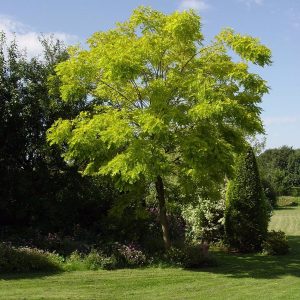
The locust tree (Robinia pseudoacacia) is a hardy, deciduous tree that is native to North America. It has a long taproot and deep, aggressive lateral roots, making it tolerant of drought and heat. The leaves are alternate, pinnately compound, and 6-12 inches long. Each leaf has 9-19 oval-shaped, serrated leaflets. The flowers are white or pink and borne in axillary clusters. The fruit is a dark brown pod, 3-6 inches long, containing several small seeds. The locust tree is an excellent ornamental plant for a variety of reasons. First, it is fast-growing and relatively easy to care for. Second, it is tolerant of a wide range of conditions, including poor soil, urban pollution, and salt spray. Third, it provides food and shelter for a variety of wildlife. Finally, the wood of the locust tree is strong and durable, making it ideal for a variety of uses.
Black Locust is relatively easy to grow from seed. The best time to plant the seeds is in late fall or early winter. Soak the seeds in water for 24 hours before planting. Plant the seeds 1/2 inch deep in well-drained soil, and water regularly until they germinate. Once the trees are established, they will need little supplemental water or fertilizer. Locust Trees are relatively tolerant of drought and poor soil conditions. However, they will grow best in full sun and moist, well-drained soil. Prune young trees regularly to encourage branching and prevent weak structuring.
9. Fringe Tree (Chionanthus virginicus)
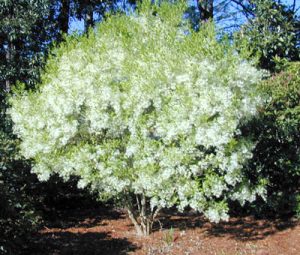
The fringe tree (Chionanthus virginicus) is a deciduous shrub or small tree that is native to the eastern United States. It typically grows to a height of 15-20 feet and has a spread of 10-15 feet. The leaves are oblong-shaped and have a serrated margin. They are dark green and turn yellow in the fall. The tree gets its name from its unique flowers, which have long, fringed petals that resemble a silk scarf. The flowers bloom in the spring and are followed by small, dark-blue berries. The fringe tree is an excellent ornamental plant for gardeners who are looking for a low-maintenance plant that is tolerant of a wide range of growing conditions. It is drought-tolerant and can grow in full sun or partial shade. The fringe tree is relatively easy to grow and care for, and it makes a beautiful addition to any garden. When planting, choose a location with moist, well-drained soil and plenty of space for the tree to spread its roots. The fringe tree is also relatively tolerant of cold weather, so it can be planted in early spring or fall. With proper care, this beautiful tree can be the highlight of any garden.


